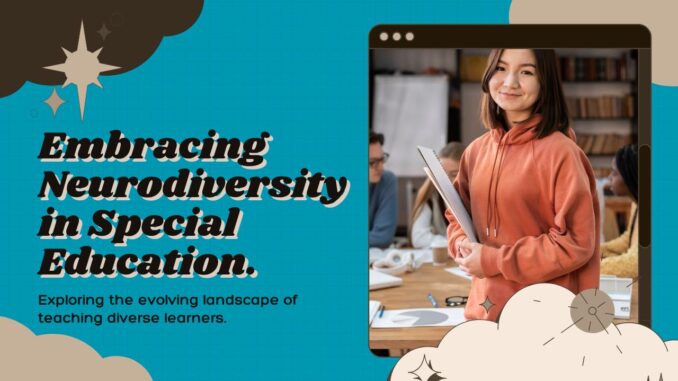
Introduction:
Neurodiversity is a concept that recognizes and celebrates the natural variation in human cognition and behavior. It encompasses a wide range of neurodevelopmental conditions, including autism, ADHD, dyslexia, dyspraxia, and Tourette syndrome, among others. In recent years, there has been a growing recognition of the importance of understanding and embracing neurodiversity in education, particularly in the field of special education. In this article, we’ll explore the concept of neurodiversity, trends in special education related to neurodiversity, challenges, and best practices for supporting neurodiverse learners.
Understanding Neurodiversity
Neurodiversity is the idea that neurological differences are a natural and valuable aspect of human diversity. Rather than viewing neurodevelopmental conditions as disorders or deficits, neurodiversity emphasizes the unique strengths, perspectives, and contributions of neurodiverse individuals. It challenges traditional notions of normalcy and pathology, advocating for acceptance, accommodation, and inclusion of neurodiverse individuals in all aspects of society, including education.
Trends in Special Education
In recent years, there has been a shift in special education towards a more inclusive and neurodiversity-informed approach. Several trends are shaping the landscape of special education:
- Inclusive Education: There is a growing emphasis on inclusive education practices that promote the full participation and meaningful inclusion of neurodiverse students in general education classrooms. Inclusive education recognizes the rights of all students to learn together in the same environment, regardless of their abilities or disabilities.
- Strengths-Based Approaches: Special education is increasingly adopting strengths-based approaches that focus on identifying and leveraging the unique strengths and abilities of neurodiverse learners. Rather than solely focusing on deficits and challenges, strengths-based approaches seek to build on students’ strengths to support their learning and development.
- Universal Design for Learning (UDL): UDL is gaining popularity as a framework for designing and delivering instruction that is accessible and effective for all learners, including those with diverse learning needs. UDL principles emphasize multiple means of representation, engagement, and expression to accommodate the variability of learners’ needs and preferences.
- Personalized Learning: Personalized learning approaches are becoming more prevalent in special education, allowing for individualized instruction and support tailored to the specific needs, interests, and learning styles of neurodiverse students. Personalized learning recognizes that one-size-fits-all approaches are not effective for all students and seeks to provide flexible and responsive learning experiences.
- Strengths-Based Assessment: There is a growing recognition of the importance of using strengths-based assessment approaches that focus on identifying and assessing students’ strengths and assets, rather than solely focusing on deficits and challenges. Strengths-based assessment methods aim to provide a more comprehensive and accurate picture of students’ abilities and potential.
Challenges in Supporting Neurodiverse Learners
While there have been significant strides towards embracing neurodiversity in education, several challenges persist:
- Stigma and Discrimination: Stigma and discrimination against neurodiverse individuals continue to be significant barriers to inclusion and acceptance in education and society. Negative stereotypes and misconceptions about neurodiversity can lead to prejudice, bullying, and social exclusion.
- Limited Resources and Support: Many schools and educational institutions lack the resources, training, and support needed to effectively meet the diverse needs of neurodiverse learners. Limited funding, staff shortages, and inadequate professional development opportunities can hinder efforts to provide high-quality support and accommodations.
- Lack of Awareness and Understanding: There is still a lack of awareness and understanding of neurodiversity among educators, administrators, and stakeholders in education. Misconceptions about neurodevelopmental conditions can lead to inappropriate interventions, misdiagnosis, and ineffective support strategies.
- Accessibility Barriers: Physical, sensory, and cognitive accessibility barriers can pose challenges for neurodiverse learners, limiting their access to educational opportunities and resources. Lack of accessible environments, materials, and technologies can exacerbate existing inequalities and hinder learning outcomes.
- Transition Planning and Support: Transition planning and support for neurodiverse students as they move from school to post-secondary education, employment, or independent living can be complex and challenging. Many neurodiverse individuals face barriers to successful transition due to lack of support, inadequate preparation, and limited opportunities for meaningful engagement.
Best Practices for Supporting Neurodiverse Learners
To effectively support neurodiverse learners, educators and educational institutions can implement the following best practices:
- Promote Acceptance and Inclusion: Foster a culture of acceptance, understanding, and inclusion that celebrates the diversity of neurodiverse learners and promotes positive attitudes and perceptions towards neurodiversity.
- Provide Universal Supports: Implement universal supports and accommodations that benefit all learners, such as flexible seating arrangements, sensory-friendly environments, and visual aids, to create inclusive learning environments that meet the needs of neurodiverse students.
- Build Relationships and Communication: Establish positive relationships and open lines of communication with neurodiverse students and their families, collaborating with them to identify strengths, preferences, and support needs, and develop personalized learning plans.
- Offer Professional Development: Provide ongoing professional development opportunities and training for educators, administrators, and support staff to increase awareness, understanding, and expertise in supporting neurodiverse learners effectively.
- Collaborate and Coordinate Services: Collaborate with interdisciplinary teams, community agencies, and support services to coordinate comprehensive and holistic support for neurodiverse learners, addressing their academic, social, emotional, and behavioral needs.
- Promote Self-Advocacy and Empowerment: Encourage neurodiverse learners to advocate for themselves, develop self-awareness, self-determination, and self-advocacy skills, and actively participate in decision-making processes related to their education and future goals.
Conclusion
Understanding and embracing neurodiversity is essential for creating inclusive, equitable, and supportive learning environments that meet the diverse needs of all students. By adopting strengths-based approaches, personalized learning strategies, and universal design principles, educators and educational institutions can effectively support neurodiverse learners and empower them to reach their full potential. While challenges such as stigma, limited resources, and accessibility barriers persist, by promoting acceptance, providing comprehensive support, and fostering collaboration and advocacy, we can create a more inclusive and neurodiversity-informed approach to special education that benefits all learners.

Leave a Reply